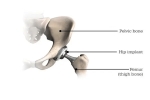In a previous blog, we discussed symptoms and conditions that may indicate you need a hip replacement. Patients of different ages and lifestyles are taking advantage of this procedure, as it has been proven to treat osteoarthritis, injuries, and other hip-related conditions.
During a hip replacement procedure, the worn-out or injured hip joint is removed and replaced with an artificial implant. This implant recreates the ball-and-socket anatomy, allowing the patient to regain movement and function of the hip joint.
If your orthopedic surgeon has recommended hip replacement surgery to address your hip pain, discussing the procedure’s details with your doctor can help you get the best results. One particular topic worth raising is the hip replacement material to be used.
Why Understanding Hip Replacement Materials Matters
Hip replacement surgeries help you move freely and without pain with your hip implant. However, one factor that can significantly affect the procedure’s success is the material used in the artificial hip’s bearing surface.
It refers to the surface between the artificial ball and socket, considerably impacting your motion. So for your new hip to work the way you want for a longer time, you need the best material for your unique condition and lifestyle needs.
But before we move on to the most common hip replacement materials and combinations, it helps first to understand the components of an artificial implant.
Components of a Hip Replacement Implant
The hip is a ball-and-socket joint made of two parts. The “ball” refers to the femoral head or the upper end of your thigh bone, while the “socket” is the deep, cup-shaped structure where the femoral head joins with your pelvis. One or both of these parts may be replaced during surgery.
In a typical total hip replacement or total hip arthroplasty (THA), the artificial hip is made up of the following components:
- Stem: A structure that attaches to the femur or thigh bone.
- Hip cup: The part of the implant that inserts into the socket of the pelvic bone.
- Ball: The component at the end of the stem replacing the femoral head.
- Liner: The part that fits inside the hip cup and allows the hip implant to move smoothly.
Hip Replacement Materials
As you start looking for the best hip replacement devices with your orthopedic surgeon, you may come across these commonly used materials in replacement procedures:
Polymers
Sir John Charnley, the pioneer of modern hip replacement, first proposed polymers as the first material of choice for hip arthroplasty. This material has remarkable mechanical properties, wear resistance and low friction, making it a suitable material for a hip replacement.
PTFE (polytetrafluoroethylene), UHMWPE (ultra-high molecular weight polyethylene) and PPEK (polyether-ether-ketone) are remarkable stable polymer systems that have been tested for THA due to their thermal stability, high wear resistance and static nature inside the body.
Metals
Metals such as stainless steels, titanium alloys and cobalt-chromium-molybdenum alloys are commonly used as orthopedic implant components, and for a good reason. Titanium and cobalt-chromium implants, in particular, demonstrate good corrosion resistance compared to other metals. They also tend to be tougher and more resistant to wear than polymers.
Titanium and cobalt-chromium alloys are also highly biocompatible, which means that the human body tolerates them well. As a result, they are unlikely to cause adverse reactions and are even found to be highly stable in the bone.
Ceramics
Ceramic is arguably the best material for hip replacement surgeries where strength, hardness and resistance are important. Its physical and chemical properties help reduce wear and tear often observed with polyethylene and metal, ultimately resulting in better longevity for artificial hips.
Material Combinations Commonly Used in Hip Implants
The three materials above can be mixed and matched, depending on your hips’ condition, your activity levels and your budget, to create the following combinations:
-
Ceramic-on-Polyethylene (CoP)
Ceramic-on-polyethylene is a type of implant featuring a ceramic bearing surface for the ball and a special plastic called polyethylene for the socket or cup.
Its early designs were prone to breaking, but designs in recent years have become more robust. With the ceramic head being rigid yet smooth, friction in the polyethylene socket leading to wear and tear is reduced.
CoP hip implants are perfect for patients looking for an alternative to plastic materials or who are sensitive to nickel in metal implants.
-
Ceramic-on-Ceramic (CoC)
As the term suggests, ceramic-on-ceramic implants are composed of ball and socket components made from ceramic materials. They were first used in 1970 when metal-on-polymer implants faced aseptic loosening and osteolysis issues.
Since then, CoC implants have been considered among the best hip replacement devices because of their toughness, scratch resistance and inert nature of the debris. They also pose lower risks of bone deterioration or dislocation, ultimately reducing the need for revisions.
Note that ceramic-on-ceramic implants can be costly and create squeaking noises.
-
Metal-on-Polyethylene (MoP)
In a metal-on-polyethylene implant, the ball component is made of metal, and the socket has a plastic (polyethylene) lining. Cobalt-chromium, titanium and nickel are among the metals often used in MoPs.
What’s great about MoPs is that they’re the most affordable type of implant combination. They also hold up well and are therefore known for their durability, implant lifespan and performance.
One drawback, however, is that the metal ball can wear down the socket’s plastic lining over time. This can cause the latter to fracture and shed polyethylene debris, which the human body can consider as a foreign object and ultimately attack. This condition can cause pain and inflammation that may eventually require hip revision.
Get Expert Advice on the Best Hip Replacement Materials for Your Needs
Since the material you’ll choose for your hip arthroplasty can significantly affect your life going forward, we hope this helped to kickstart your research. But besides reading up on this information on your own, it’s crucial that you find a skilled and dedicated orthopedic surgeon. There’s no one best material for hip replacement, so consulting with a highly trained specialist can help you identify the most suitable implant for your condition.
Dr. Benjamin Domb is an orthopedic surgeon specializing in various hip conditions and is here to help you regain a pain-free life. Factors such as your hip condition, age, weight and activity level will be carefully considered to find the most appropriate solution for you.
If you’re considering joint replacement surgery for your injury or degenerative joint disease, get in touch today to schedule an appointment with one of our highly trained hip specialists. As the first surgeon in the U.S. to perform an outpatient robotic hip replacement, you can expect the best from the best.

